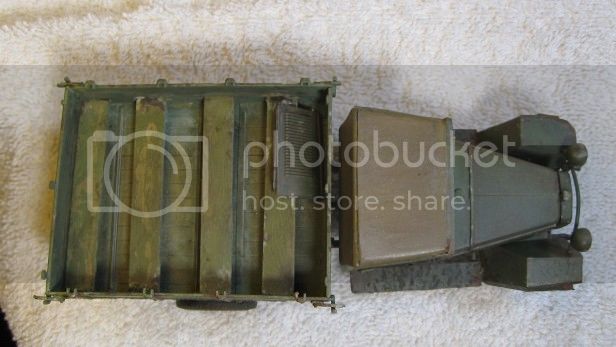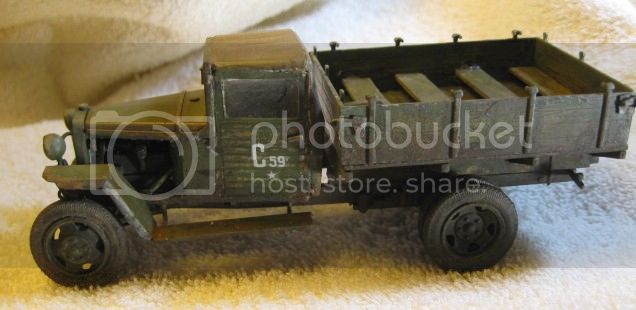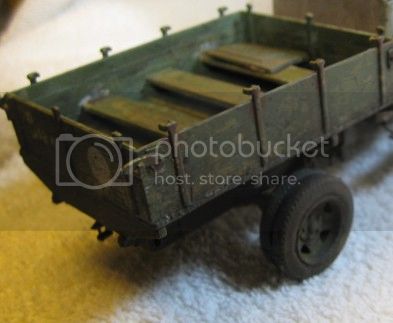Paints: Revell Aqua Color, Gunze Mr. Hobby, Vallejo Model Color
Weathering: Rustall System, Iwata Com.Art paints, Vallejo Acrylic Mediums

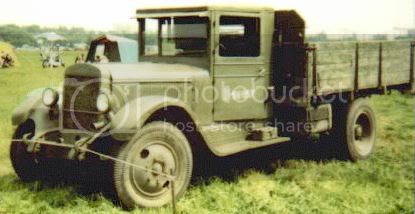
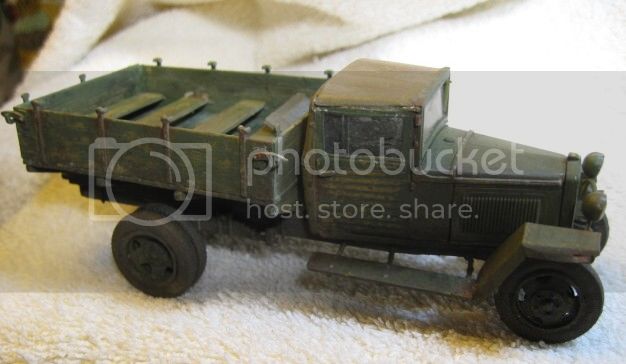
I bought this kit for $10 during a Dragon sale a year back. I figured it was funky, cheap, would make for a nice weathering experiment and was important historically. It was a whim buy and I had no idea that anyone else made Rooskie Model As. The result was an experience.
The Truck:
This is a model of the GAZ MM utility truck. The real deal was a Model A Ford pick-up built in the worker's paradise from the late 1920s to the early 1950s. (Henry Ford hated labor unions but seemed to think Stalin was agreeable. Odd era.) In large use by 1941, the major factory near Minsk was evacuated in front of advancing Panzers by rail across the Urals where truck construction began again immediately. As much of the equipment for “frills” (like doors and fenders) were left behind, the new models were built with as much wood and canvas as possible. (Yes that meant that Rooskie truckers were riding the ice roads without doors – canvas flaps were good enough.) In 1943 the “improved” model shown here was available. It retained many wooden components but did receive door frames and sheet metal fenders. There were a multitude of variations of this basic truck.
The Kit:
I found few reviews of this kit online. An inbox review from a good site gave it good marks for molding. Someone else mentioned it was an old Japanese kit that could make a good truck. Others talked about “warped plastic” and a “pig” of a kit. Let's just say it is old and that nothing really fits. This would have been the kind of build that some modelers relish – many rewards for precision and foresight. I began with a serious blunder. Because I was thinking of a weathering experiment, I built the thing like a ship – in modules. In retrospect I should have built it like a tank – part A-Z in order. The problem was that everything, and I mean everything was off just a little. When doom loomed I got out my compass and ruler and found that some parts were simply not going to fit. But the bits and pieces came together okay. Let's just say that fixing a fit between one piece and another is easier than fixing the fit between one module and another. It didn't help that the instructions had part numbers wrong, did not mention several parts available and did not distinguish an orderly progression when it was needed. I must admit, however, that the diagrams were all there – and I didn't look closely enough at them. What was missing of course was any kind of “key” that would prevent a part from being inserted in the wrong direction – the kind of thing you take for granted with DML or Tamiya. This kit demanded a steady hand, clear eye and knowledge that it required it. The result was the worst build I've done. All I can say is that I sharpened my skills on using CA, a variety of seam fillers and a selective camera. And I built the kit about four times. But I got it together. Literally five minutes before beginning photos, I dumped a bottle of Testors cement on top of the canvas cover – missing the model itself by about an inch. Fortunately I didn't want the cover on because the bed was important for weathering, but there is a lesson in that.
Painting:
The kit was primed with Vallejo acrylic-polyurethane which I really like. Then I made a brew of Revell Aqua Color Sand Yellow and Mr. Hobby (the water based Gunze – not Mr. Color) dark green for the base. Aqua Color does thicken quickly in the bottle (this one was a year old and unopened) so I thinned it was a new purchase – Vallejo Acrylic Thinner. The canvas parts were painted with Vallejo Model Color Khaki Brown and the wood Model Color Iraqi Sand. I'm not sure what's in the Vallejo thinner – I'd guess water and a combination of retarder, leveler etc. All I can say is that it airbrushed wonderfully. This was very good news to yours truly because I have fifty bottles of Model Color: the stuff will airbrush great with Golden Airbrush Medium but that imposes a slow dry an kind of “layered” look (which I like). The Vallejo thinner laid down a very Tamiya-like coat and dried quickly enough. The stuff is also non-toxic and odor free which I like. (Might note that some of my Golden acrylics use zinc and cadmium for pigments – both require a mask which I never use because you can't smell the stuff.) I did three shades of green and two of sand and khaki.
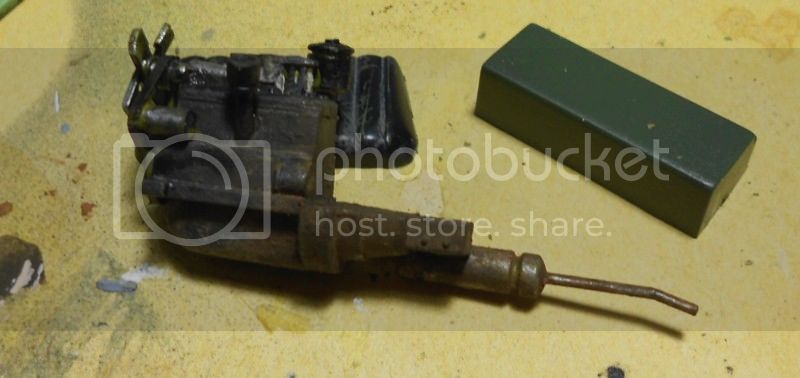
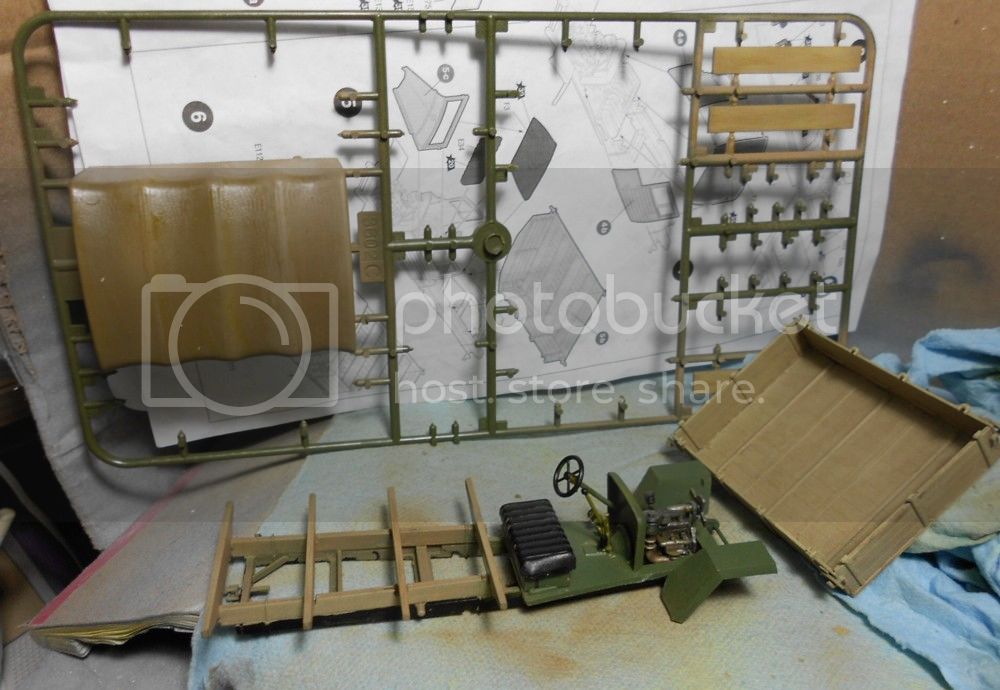
Weathering:
Should comment on what I was after in this stage. I could have weathered a Red Army Model A to an inch of oblivion. I didn't want that. I was thinking in terms of a truck that was badly made, a few months old, and well used. I was trying to improve techniques as I conceive them for WWII AFVs. I rusted the thing mildly because a badly made truck would rust fast in Russia. (Did I mention that I spent many a night blind drunk in an American version?) And chipped it. But what I was really after was the paint worn away from the wood. I don't think a 2 wheel drive truck would have been off-road a lot, but it certainly would have been chipped and dented a bit. But above all faded and dirty. (From what I can tell after two years of studying the photo record was that regardless of age and condition, any AFV in WWII was dirty. Emulating dirt, grime and dust are probably not the grandest skills in weathering, but if not done right the model doesn't work.)
I'm in St. Paul and don't have all of my weathering junk so it was time to try an all-acrylic rendition. I was inspired by a very good AK Acrylics DVD made by Mig Jimenez which was aimed at people who don't like solvents and the most inventive of the series to my eyes.
After the first base coat was down, I put on a coat of AK “Worn Effects” (I tried hairspray and it worked as well but smelled like hairspray) and then covered it with a coat of lacquer clear. (Almost all acrylic weathering. I also use lacquer thinner for cleaning airbrushes.) I've found that without this layer, the “hairspray” technique quickly eats to the prime. Then a last blast of green over the wooden areas. I used a bristle brush to remove some of the green and think the results worked pretty well. (You can also see the Rustall in this photo.)
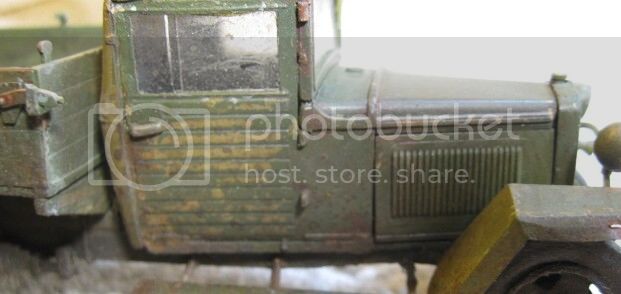
Next was fading and beginning the dirt stage. As noted I did post-shade the model, but the main vehicle here was Iwata Com.Art paints. These are acrylics (several other brands make the same type of paint, including some of the most famous makers of artist paints) designed for painting soft surfaces. They have (I'm almost positive) a dye pigment, a water-based solvent, (again, non-toxic and no smell) and are not designed to paint plastic. That's their great advantage for weathering. Varying greatly in opacity, I used combinations of light opaque and light translucent colors for fading. Below is the canvas top prior to its destruction: note the difference between the section faded and that not. (The photo was taken before smoothing the faded texture: looked like faded canvas to me when done.)

Next was a liberal employment with a sponge of Com.Art Transuclent Smoke which does a better job of emulating a smudge than anything I know. This stuff went especially into the bottom of the bed.
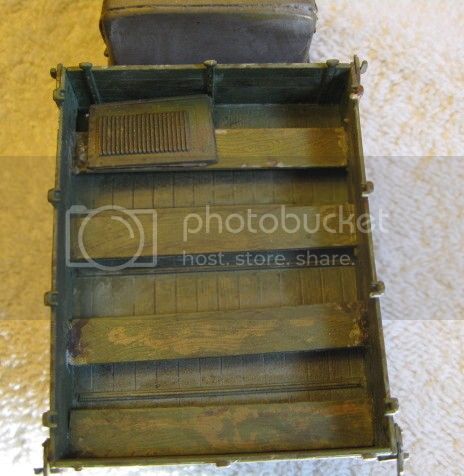
I then gave the model (actually the modules – I hadn't faced calamity yet) a filter with Vallejo Acrylic washes – a mixture of sepia and umber. I used the black-ink fluid that came with Rustall for pin washes and found it fine but a little sublte. I put a dab of Golden Carbon Black (a color blacker than Stalin's soul) into the Vallejos and finished the pinwashes. On the grill I added some Vallejo Oily Steel which may be the single most useful color in the modeling world. I wanted rust to look like it was starting but hadn't really hit. I used several Vallejo earth colors for chipping and where I wanted a rust point to start there was just a bit of Choclate Brown. Then I used a railroad product called Rustall along with the rust colored Com.Arts. The rust part of Rustall is rust in a liquid which makes it very mild – at first. Com.Art makes a railroad set which I use and both suggest the same thing: put a dab of paint on the side, and then add a dab of baking soda. The result is a kind of three dimensional rust spot – very small in this case, but just the ticket to serve as a base for thin streams of the stuff dripping down. In my case the impact evokes the beginning of rust – another couple of coats and it would have looked like a proper junker.
I tried Mig's techniques for acrylic pigments and found it very good indeed. The technique is to use Vallejo thinner as a liquid agent and acrylic matte medium for a fixer. (Mig recommends Vallejos version, but this is a standard medium in art stores and I used Liquitex. Might note that per volume, art supplies are made in much greater volumes and are considerably cheaper than modeling products. A $6 bottle of Matte Medium is 8 ounces and would last about twenty years.) It was very interesting to see the difference between the types of pigments. I had one color of MIG, several of Micro Mark's Doc O'Brien and three made by Sennelier – the world's premier oil paint maker. I'm positive that O'Brien has some kind of additive – it might be simply well ground pigment chalk. The advantage is that it will stick and hold if ground into a surface – especially a coarse one. MIG is finer and mixes with other MIG pigments very well (Doc's stuff kind of coexists in two or three colors) but I'd guess it also has something that keeps it on. Sennelier (the cheapest per volume by far) is almost like a different product. It is fine in the sense that a paint pigment is fine and nothing is added. (This is called an inorganic pigment and is used for earth colors: they're made from natural minerals, chalks etc and no dyes.) Sennelier is incredibly fine and the user might well use a mask – you don't want to handle this stuff roughly or it will be all over. Now, you're using all of this stuff to make dust and, in my case, dry mud. (I skipped wet mud.) Note, we don't use any sand. Changes in application from tanks are in order. Instead of making a brew to paint on, you put on fixer and then pigments – or the opposite. Very easy to fine tune this method but I didn't want the very heavy cover like you might see on a tank. (You could certainly do it but adding layers.) The photos below gives you an idea of what I'm thinking of.
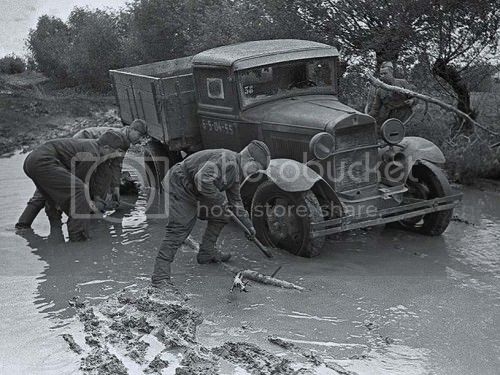

The final step was the application of a coat of dust. The standard approach to this is to apply a very diluted coat of acrylic paint. Considering scale this is probably right. But perhaps the best way to emulate dust is with dust. So I used Sennelier pigments mixed with Tamiya A-20 thinner which is a good fixer. I used a Paasche VLS airbrush for this and blasted from a distance. It's hard to see it applying, so I had put a bit of masking tape over the area (more or less) covered by the windshield wiper and you can see what's all over the model:
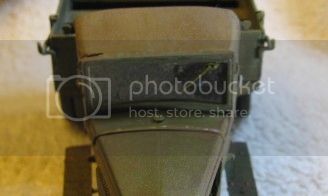
One more thing. Acrylic weathering is extremely forgiving. Stalin made every color of Ford as long as it was green. A green pick-up with mud and dust doesn't pop you in the face visually. I thought I had good history but decided to remove some of the weathering (a day after done) with some Windex just to give back a little color to the grill: kind of like reverse dry-brushing. I've since done the same to the tires and wheels for visual effect – the camera is in bed so you'll have to take my word for it. The kit had an engine so I left it revealed on one side.
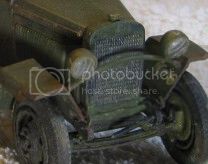
More pics below:


